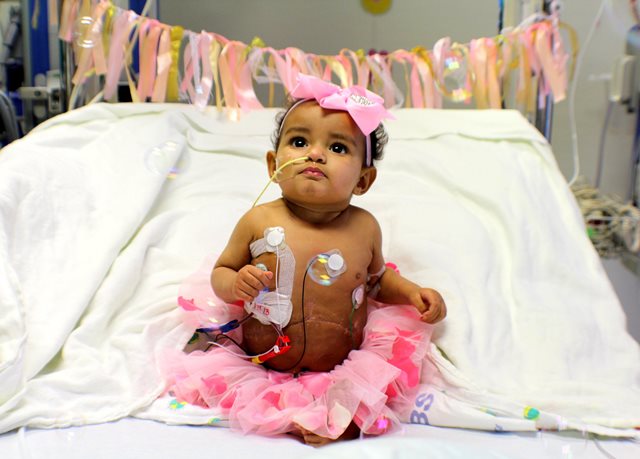 Picturing her daughter making it to her first birthday was difficult for Rachael Rowe as she watched her baby struggle to survive each passing day waiting for a liver transplant.
Picturing her daughter making it to her first birthday was difficult for Rachael Rowe as she watched her baby struggle to survive each passing day waiting for a liver transplant.
Time officially took its toll on Feb. 6, 2018 — four months after 10-month-old Raylee was put on the transplant waiting list.
“I remember it was 3:00 a.m. in the morning when I heard Raylee screaming in pain,” said Rowe. “Never in my life had I heard a baby cry like that before. It was terrifying.”
After spending three hours trying to comfort her normally smiley and happy baby, Rowe took Raylee to the emergency room near their home in Portland, Oregon.
“They didn’t know what was wrong with her until the lab results came back,” said Rowe. “It showed that her blood count numbers had spiked — her body was shutting down.”
Raylee’s life was hanging by a thread as doctors scrambled to find a way to get her from Portland to Seattle Children’s for a liver transplant before it was too late.
A turbulent start at life leads to a fight for survival
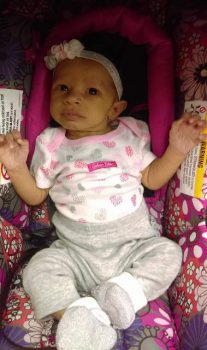 The first sign of things to come began just 48 hours into Raylee’s life.
The first sign of things to come began just 48 hours into Raylee’s life.
“Raylee weighed a healthy 7 pounds and 5.5 ounces when she was born,” said Rowe. “Then just a day after she was born, there was a six-hour period where she didn’t want to eat. I wasn’t too concerned at first because she went back to eating regularly later that evening.”
From 6 weeks to 2 months of age, Raylee struggled to gain weight.
“Doctors thought I may have not been producing enough milk,” said Rowe. “I had to begin using formula to feed her.”
Then one afternoon, an alarming sight in Raylee’s diaper put Rowe in a panic.
“I noticed blood in her diaper, and her stool had changed colors,” said Rowe. “I thought that maybe it was because of her new formula, so I called her doctor who said to just monitor her, but if it happened again, to take her to the emergency room.”
A few hours later, the blood appeared again.
Rowe rushed Raylee to the emergency room where she underwent testing to determine the cause of the blood — and the news was devastating.
“That’s when we were told that Raylee might have a condition called biliary atresia,” said Rowe. “They referred us to Seattle Children’s for an official diagnosis and treatment.”
About 1 in 15,000 babies are born with biliary atresia, and doctors do not know why it occurs.
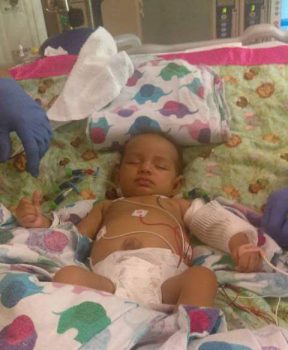 Biliary atresia is a liver condition that occurs when a baby’s bile ducts do not form normally. Instead of being open tubes to drain bile from the liver, the bile ducts are missing or they are blocked because of scarring.
Biliary atresia is a liver condition that occurs when a baby’s bile ducts do not form normally. Instead of being open tubes to drain bile from the liver, the bile ducts are missing or they are blocked because of scarring.
“In most cases, biliary atresia presents in early infancy, and if found early enough, a corrective procedure called the Kasai can be performed,” said Dr. Evelyn Hsu, medical director of Seattle Children’s Liver Transplant Program, who played a role in treating Raylee. “Unfortunately, it is not detected in many babies early enough and can progress to advanced liver disease, which was the case for Raylee. For these babies, unless they receive a liver transplant by the age of 2, the risk of death is nearly 100%.”
Seattle Children’s has the only pediatric liver transplant program in the Pacific Northwest with a team of among the most experienced pediatric liver transplant surgeons in the United States.
Rowe was advised by her care team at Seattle Children’s that Raylee needed a transplant much sooner due to the extent of her disease progression.
She was placed on the liver transplant waiting list on Oct. 10, 2017.
“Once we were put on the list, it was a waiting game from there,” said Rowe. “We were able to keep Raylee stable in the beginning as we made trips from Portland to Seattle almost every other week or so for clinic visits — but as time passed, I could tell she was really struggling to survive.”
Holding on for a second chance at life
 Approximately 1 in 10 children on the U.S. liver transplant wait list dies every year.
Approximately 1 in 10 children on the U.S. liver transplant wait list dies every year.
This startling statistic brings to light the issues around pediatric prioritization in the allocation of livers for transplantation.
“Raylee’s case was made worse because there were no donors or offers available as soon as she needed it,” said Hsu. “If she was given an offer sooner, we could have done the transplant and avoided a lot of the problems that came with the wait.”
Throughout Hsu’s career as a transplant physician, she has witnessed firsthand the troubling trend of children getting sicker the longer they wait for a transplant. Raylee’s situation clearly reflected that for Hsu.
“Raylee became so sick that she was put on a dialysis machine, needed plasma exchange, and required a breathing tube,” said Hsu. “She was at a high risk of dying at the time of her transplant.”
Nearly five months on the wait list, Raylee’s health hit its lowest point. In early February 2018, the night Rowe awoke to her daughter’s agonizing screaming, Raylee went into liver failure and was rushed to Seattle Children’s.
“She was so sick that she could barely stay awake,” said Rowe. “I just held her in my arms as she slept, and I prayed my hardest hoping that I wouldn’t lose her.”
Waiting was no longer an option and a transplant was critical for her survival.
Doctors rushed to find Raylee a donor. Rowe’s sister-in-law was the only family member that was a suitable living donor match for Raylee.
The liver is an organ that can regenerate, and as little as 25% of a liver can grow into a whole liver again, which makes it possible for surgeons to remove part of a healthy liver from a living person and transplant it into someone whose liver is failing.
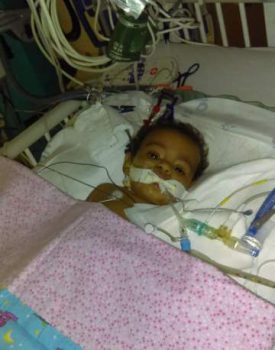 While it can be an effective method, there are a variety of factors and requirements involved for a child to be considered for a living-donor transplant, including the severity of their condition, how medically stable they are and the urgency of their need. Living donors must also be adults who volunteer freely and meet strict health and other requirements. These are among the reasons why it may not be the first treatment route that doctors offer.
While it can be an effective method, there are a variety of factors and requirements involved for a child to be considered for a living-donor transplant, including the severity of their condition, how medically stable they are and the urgency of their need. Living donors must also be adults who volunteer freely and meet strict health and other requirements. These are among the reasons why it may not be the first treatment route that doctors offer.
Just five days before Rowe’s sister-in-law was scheduled for the procedure to donate her liver tissue to Raylee, an offer from the list arrived.
“I felt like were given a miracle,” said Rowe. “My daughter finally had a chance to live.”
Raylee’s transplant surgery was scheduled for the following day.
It was a long and nerve-racking wait for Rowe as Raylee was taken into the operating room. It wasn’t until more than 12 hours later when doctors told Rowe that her daughter’s transplant was successful and she could finally see her.
“I was so amazed and happy seeing Raylee wake up for the first time after her transplant,” said Rowe. “It made me think about how much she’s been through in her short life — it’s more than what some people go through in their entire lifetime. She’s such a strong little girl with so much life ahead of her.”
Reevaluating the system to save children’s lives
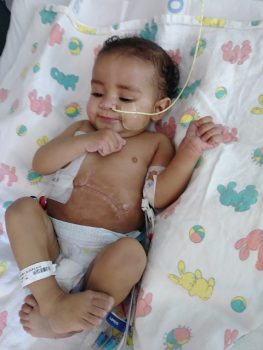 As one of Raylee’s providers, seeing the 10-month-old go from being severely sick to receiving a lifesaving transplant brings powerful meaning to Hsu’s work as both a transplant physician and relentless advocate for creating a system that better prioritizes pediatric patients on the organ transplant waiting list.
As one of Raylee’s providers, seeing the 10-month-old go from being severely sick to receiving a lifesaving transplant brings powerful meaning to Hsu’s work as both a transplant physician and relentless advocate for creating a system that better prioritizes pediatric patients on the organ transplant waiting list.
“It’s amazing that you can take a baby that is at death’s door and give them life through a transplant,” said Hsu. “It is miraculous to me.”
That’s why Hsu is helping to shine a light on the problems with the current point system in place in the U.S. that determines the priority in which a person receives an organ.
“When I first started doing transplant medicine in 2011, I noticed there were a lot of very sick kids that we had to request extra points for to add to their calculated score simply because they couldn’t compete with other adults waiting on the list who were older and sicker with much higher scores,” said Hsu.
“Then I looked at places like Brazil, Argentina, France, Canada, and parts of the European Union that made sure children were put ahead of adults on the waiting list because of society’s ethical argument for prioritizing children,” added Hsu.
These observations helped to propel Hsu’s research on pediatric organ allocation. Her most recently published research in the Journal of Gastroenterology focused on the analysis of liver offers to pediatric candidates on the transplant wait list.
The data gathered in Hsu and her colleagues’ research provided staggering numbers showing the disparities of children dying on the transplant wait list to adults transplanted with pediatric organs.
“We found out that in a five-year period, there were more than 300 children that died on the wait list, while 1,600 adults received a liver from a pediatric donor,” said Hsu. “This happens because of the geographic rules in place determining who is first to receive an organ.”
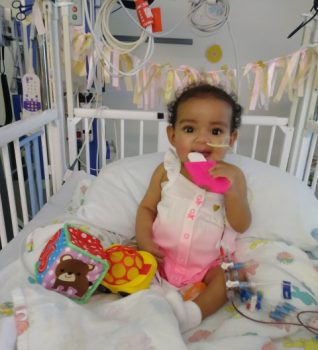 To help illustrate the issues in these rules, Hsu uses Raylee as an example.
To help illustrate the issues in these rules, Hsu uses Raylee as an example.
“She was on the wait list with the highest score we could possibly get her and considered high risk status because of being in the intensive care unit and on dialysis,” said Hsu. “But in a situation where a pediatric organ would become available in Oregon, and if there weren’t any children on the list in that area to take it — it wouldn’t be offered to Raylee — it would first be offered to adults in Oregon.”
While the data illuminates these issues, Hsu says there continues to be a struggle to provide a strong voice to advocate for these children due to the vocal majority representing the adult population on the wait list who perpetuate the misconceptions that doubt these discrepancies.
To help correct these misconceptions, Hsu emphasizes the need for widespread support.
“We really need to bring awareness to the public and elected officials who can help direct and strengthen the conversation around change,” said Hsu.
The bottom line for Hsu is that no child should have to die waiting for an organ.
“I tell patient families that it’s important to never lose hope,” said Hsu. “As a transplant physician, it gives you a great amount of optimism when you see a child doing so well after receiving a transplant. But we cannot stay complacent. We need to work harder in fighting for the children still in need and who deserve to live a full and healthy life.”
The greatest gift
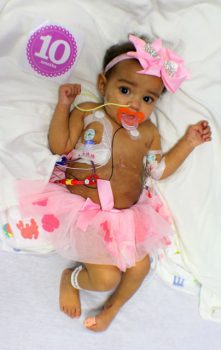 After overcoming the long and arduous journey to Raylee’s transplant, Rowe is looking forward to celebrating her daughter’s first birthday — a day she had a difficult time picturing three months ago.
After overcoming the long and arduous journey to Raylee’s transplant, Rowe is looking forward to celebrating her daughter’s first birthday — a day she had a difficult time picturing three months ago.
“For other parents going through what I went through, I want to tell them that it’s tough, but don’t lose hope,” said Rowe. “Just like they’re strong, we also have to be strong for our kids.”
Rowe hopes that sharing her experience will encourage more people to become organ donors and bring awareness to the disparities in the system that provides organs to children.
“It’s unfair knowing that so many children have to compete against other people to get the organs they need to live,” said Rowe. “That’s why the work that Dr. Hsu is doing is so important. These kids should have a chance at life, just like Raylee.”
Among the presents that Raylee will open on her birthday, Rowe says the biggest one arrived already.
“She was given the gift of life,” said Rowe, “and that’s the one that matters most.”
To learn more about organ donation, and to register to become a donor, visit Donate Life America.
Resources:
- Seattle Children’s Transplant Center
- Pediatric Liver Transplant Program
- United Network for Organ Sharing (UNOS)
- Analysis of Liver Offers to Pediatric Candidates on the Transplant Wait List, Journal of Gastroenterology, Oct. 2017
- Organ network needs to keep the voice of children’s advocates, STAT News

